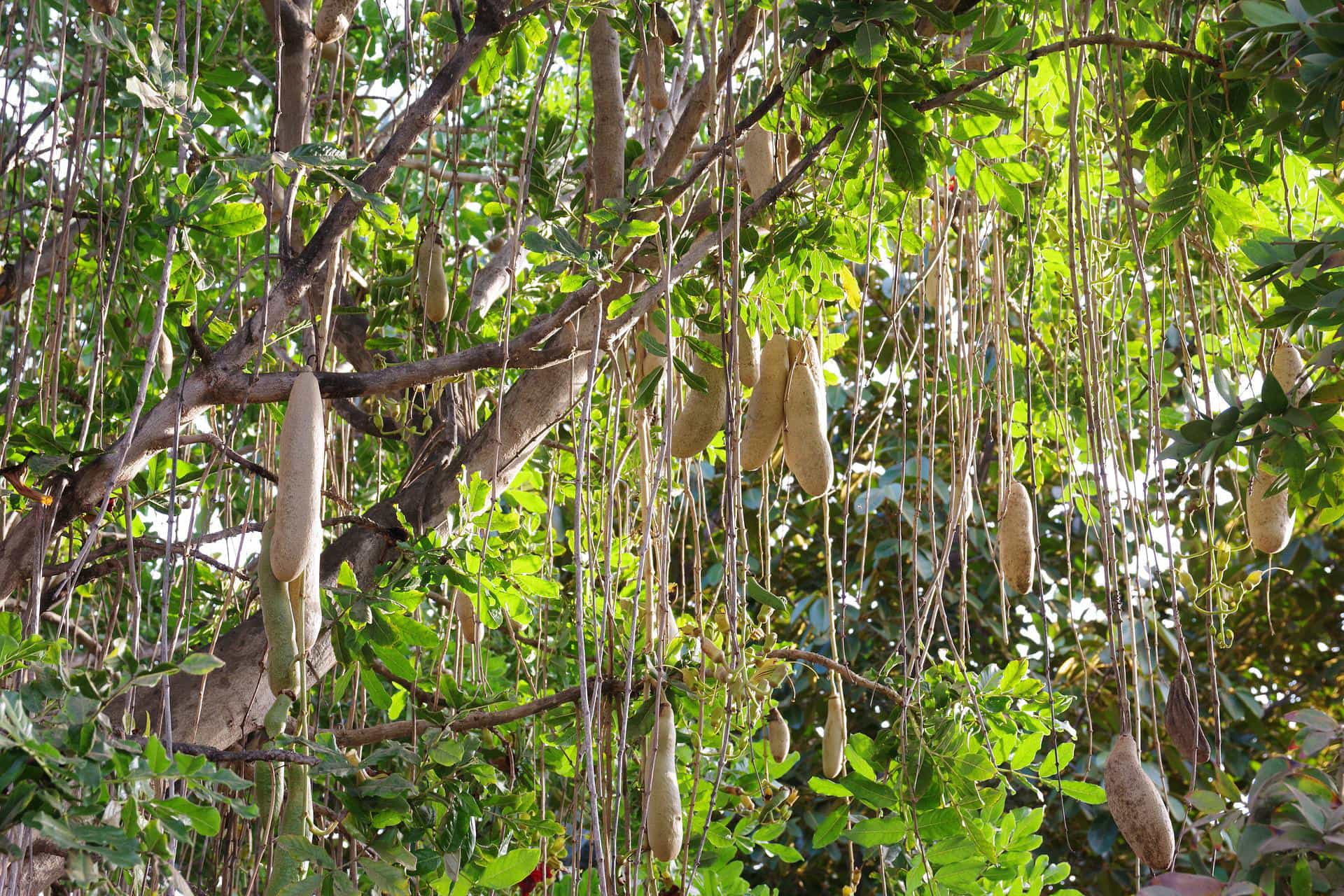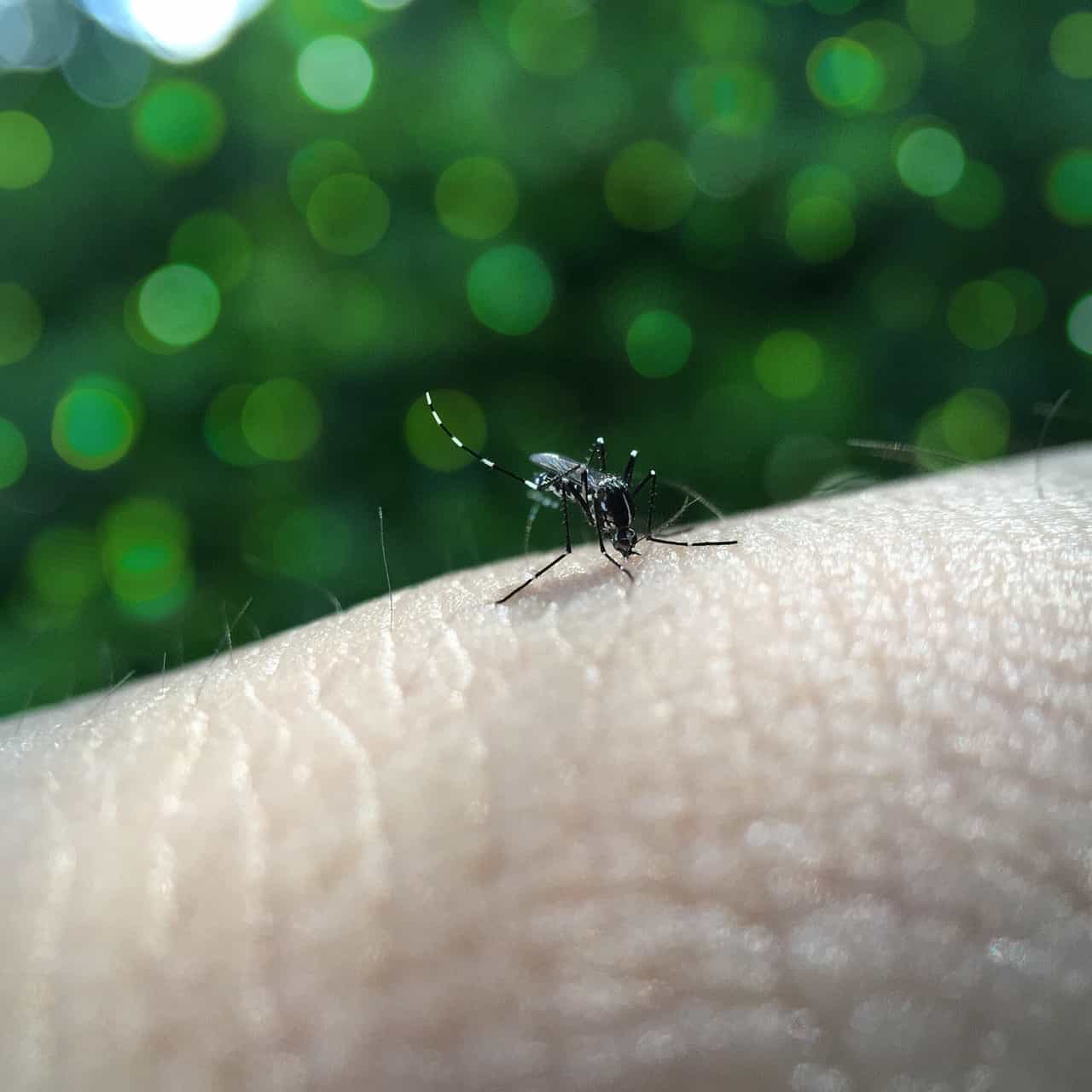Many medical experts insist there isn’t a cure, but the fruit of an African tree, Kigelia Africana can reverse psoriasis. I know. It reversed my condition. Here’s proof.
By PENNY SWIFT
Psoriasis Can be Cured
Millions of people suffer. But instead of getting medication that can cure the condition, typically, they are told they need to learn to live with it. That’s exactly what happened to me.
The National Psoriasis Foundation confirms that more than 7.5 million U.S. adults are affected by psoriasis.
Officially, they do not endorse any medications or specific treatments for psoriasis. Instead, they are adamant that “there is no cure” advising suffering to find ways to handle the challenges of living with psoriasis.
But when doctors couldn’t help me get rid of what I can only describe as a demoralizing skin condition, I began a personal mission to find something that could help me. I knew very little about psoriasis and had only met one person who suffered from the condition. She confided that she had been to the Dead Sea to try and cure the disease, but it didn’t help for more than a short while. So, I was already forewarned that I would likely have to live with psoriasis forever.
I had no inkling that I would find a product made in South Africa (where I live) that contains a miraculous component that can reverse psoriasis. It certainly didn’t provide a quick fix, but my skin has been clear now for more than seven years (2022). There are many case histories that show mine is not an isolated case.
While some people might call it long-term remission, for me, it remains a cure.
Cure: Get rid of an illness or problem
Made from the pod of Kigelia Africana, better known as the African sausage tree, the “natural skin disorder product” I discovered cost me a fraction of the price of the expensive skin medications doctors prescribed, that didn’t work.
Before and after: 2008 – 2010 – 2015. Pictures: Janek Szymanowski
What is Psoriasis?
My own introduction to the problem was via a friend who was a hugely successful PR for an international hotel group, and who had a child in the same class as my oldest son. I couldn’t see her condition, and nor could anyone else – unless she chose to show them. But as I got to know her better, she showed me the skin condition that was hidden by her clothes. It was awful, and all I could do was empathize. Little did I realize that I would also cross swords with psoriasis, and discover firsthand what an ugly disease it actually is.
As a journalist, I know that psoriasis is a condition that has had sufferers screaming for help for a very long time. But it was only when I developed psoriasis that I researched the condition.
I discovered that it is a disease that causes various types of inflammation and lesions on the skin that, at best, are sore and itchy, and at worst, unsightly, painful, and disfiguring, sometimes debilitating. Its cause isn’t known, but it is considered to be an immunological condition, and there are a number of typical triggers including stress and infection. Because of the social stigma, sufferers usually try to cover it up, even though it is not contagious.
It is generally agreed by the medical fraternity that there is no cure for psoriasis. But as I’ve already said, there are people whose psoriasis has been cured or at least forced into long-term remission, including mine.
How Does Psoriasis Develop?
In truth, there is still no definitive evidence of how psoriasis develops. But this is what
The National Institutes of Health (NIH), describes psoriasis as a non-contagious immune system problem that normally occurs in adults and sometimes recurs in families. Causes, they say, can be anything from stress, infection, medication, or even simply dry skin conditions.
They explain that our skin cells that grow deep in our skin rise to the surface in a process known as cell turnover. This usually takes about a month. But when your immune system causes psoriasis, it can happen in days because the cells rise too fast.
“Psoriasis can last a long time, even a lifetime. Symptoms come and go,” they say.
So, in essence, they are saying that psoriasis is a medical problem that relates to the immune system. Furthermore, it tends to attack the body and then never leave.
The Centers for Disease Control and Prevention (CDC) describes psoriasis as “a chronic autoimmune skin disease that speeds up the growth cycle of skin cells.” Identifying it as a serious public health problem, the CDC began focusing on psoriasis in 2010, which at that stage was estimated to affect about 6.7 million adult Americans.
Two years later, they published an “analysis” that stated amongst other things that psoriasis was “significantly associated with” both smoking and obesity.
I have never smoked or been obese!
The World Health Organization (WHO) reported at its 67th World Health Assembly in May 2014 that psoriasis was “a chronic, non-communicable, painful, disfiguring, and disabling disease for which there is no cure.” It also stated that people suffering from psoriasis were more at risk for various co-morbid conditions including obesity, diabetes, stroke and various cardiovascular diseases, ulcerative colitis, and liver disease – again, nothing I have suffered from.
Further, the report said, as many as 42% of psoriasis sufferers would develop psoriatic arthritis that would at the very least cause pain, swelling, and stiffness, and at worst would develop into permanent disability and disfigurement.
“Too many people in the world suffer needlessly from psoriasis due to incorrect or delayed diagnosis, inadequate treatment options, and insufficient access to care.” WHO
So, how could there possibly be a cure for this supposedly incurable condition? I believe the key is in the very words of WHO. After all, quick diagnosis and proper treatment is the key to a cure for just about any disease.
Kigelia: An Underestimated Source for Treating Skin Diseases
The cure source might seem like an unlikely one, but the pod of the African sausage tree has also been found to be “active” against skin cancer, fungal infection, eczema, and other skin problems.
Common throughout Zimbabwe, Zambia, Malawi, and other parts of southern Africa, the sausage tree is quite a plain-looking tree, except for its extraordinary sausage-shaped fruit that is spectacularly huge. Not only do the enormous pods weigh a lot, but they are also almost impossible to cut.
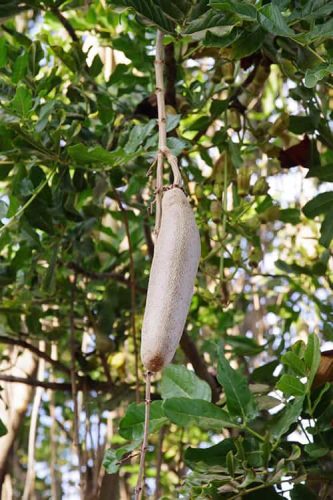
A pod from Kigelia Africana
Various parts of the tree, including the pod, are commonly used in traditional African medicine for just about anything from treating constipation and gynecological disorders, to sores and snake bites.
According to the American Botanical Council, there are anecdotal reports of crude creams made from the fruit being used in South Africa to treat cancerous skin conditions. Specifically, solar keratosis, which is a precursor to skin cancer, and malignant melanoma.
Perhaps ironically, about two years after I’d discovered the Kigelia-based skin treatment, we moved to a house that had a huge sausage tree bursting with pods. That’s when I discovered they are as tough as nails and virtually impossible to cut. And I wasn’t about to try and make my own medication!
A Personal Journey With Psoriasis
Although a reasonably ardent believer in alternative medicine, when I realized I had developed a chronic skin condition that was probably psoriasis, I went to a general practitioner. When the expensive skin medications he prescribed failed to make any difference to the condition, I realized I would probably have to go to a specialist dermatologist. But first I did some serious research – and it paid off.
Clearly, as you’ve seen, there is no agreement on what causes psoriasis in general. But the direct trigger for me was another skin condition that had resulted from a series of very unpleasant insect bites. It had happened before, and I knew immediately that the rash I had developed all over my body was from a mite that burrows into hay and straw. All I had done was to sit on a bale of contaminated hay!
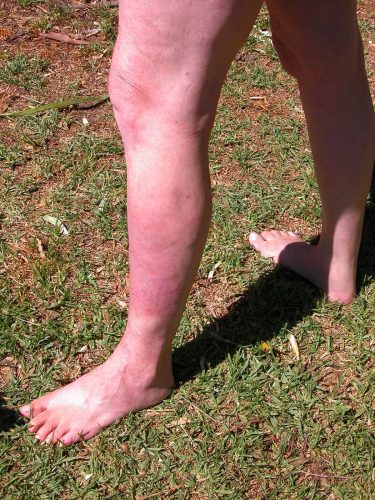
Legs that I kept hidden for years. Picture: Janek Szymanowski
I immediately self-medicated with a parasiticide soap that contains 5% Monosulfiram and is manufactured to prevent and treat a range of skin infections and rashes from severe eczema to scabies and head and body lice. It eased the itching but didn’t clear the rash. I also used tried-and-tested calamine lotion and antihistamine cream for the itching.
It was some months later that I went to the doctor. He confirmed that I had psoriasis and prescribed a very expensive cream that was even less effective than the soap had been. After a repeat prescription, and still no results, I started my Internet search and found the product that cured my skin condition.
It is totally natural and supplied as a colorless solution (that you spray on) together with a lotion that you rub into the skin once the solution has dried. The Kigelia solution is absorbed into the skin and it starts to repair it at a cellular level, from beneath the skin, getting rid of toxins and harmful bacteria. Rather than keeping the skin moist (which several other remedies do), this particular treatment allows oxygen to get into the skin while it is kept as dry as possible. However, the manufacturers, Oxylabs, advise patients to use a nourishing skin cream to ensure their skin doesn’t dehydrate.
I began my personal experiment in 2008. As mentioned above, it wasn’t quick. I wore long skirts and jeans 24:7 because my skin looked so horrible. While the original rash was all over my body, the resulting psoriasis was mainly on my legs. But it was when it started appearing under my arms and on my elbows, that I became seriously alarmed.
The solution and lotion seemed far too simple, but I persisted daily for more than two years … watching as it slowly started to abate.
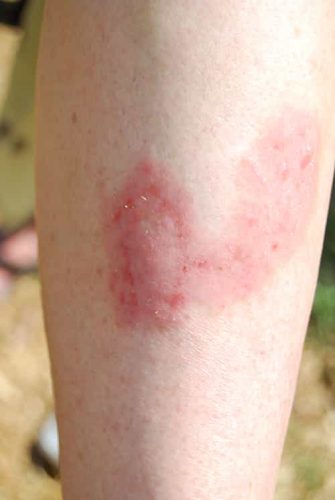
After two years, the angry, red symptoms of psoriasis have nearly disappeared.
Picture: Janek Szymanowski
But a typical characteristic of psoriasis is that it is variable and tends to change its form, flare-up, improve, even go into remission, and then flare up again.
As the raised red skin on my legs shrunk, I began to get lesions on the palms of my hands. At one stage they were so bad they were open and seeping. We didn’t photograph them at their worst!
Lesions forming on the palm of my hand. Picture: Janek Szymanowski
Eventually, the inflammation on my legs and body disappeared completely, and it has never reappeared. My hands eventually also cleared, though inflammation on them was triggered and recurred until about 2015 – seven years ago.
Other Psoriasis Success Stories
The Kigelia Africana product I used was the brainchild of two long-term psoriasis sufferers. Brigitte Ramsay and Dr Joey Gobind. Brigitte had suffered from the condition, which was mostly triggered by stress, for 16 years when she discovered the miraculous plant extract.
In 1997 she experimented on herself, and it took two months for the condition to vanish. Dr. Gobind, a general practitioner in Johannesburg, had also suffered for many years. He tried Brigitte’s original homemade remedy and started treating his patients with the same concoction.
Then the pair got serious, trademarked their products, and started a very low-key business, selling only via the Internet from February 1994. The business is still low-key, and they claim only to have enabled sufferers to go into remission, although some, including Brigitte, have found permanent remission.
Most of the patients who have subsequently used their Kigelia Africana solution and lotion had previously tried cortisone creams and other prescription medicines. Photographs and testimonials on their website tell the story.
But theirs is not the only product that works both to reverse psoriasis and inhibit chronic skin conditions. As long ago as 1995, a British study by a King’s College, London biochemist. Dr. Peter Houghton found that an extract from Kigelia was able to counter skin cancer and melanoma cells. Researchers have also found that the plant has antifungal and antibacterial properties, amongst other things.
So, if doctors tell you your psoriasis cannot be cured. Don’t give up. I believe there is a cure.




